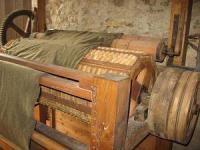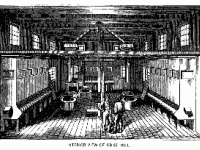 The waters of the Niger had attracted settlers to the area as early as 1796, long before Daniel and Lorenzo Way’s arrival. By the late 1830s, several families were established. Those families bore the names Baxter, Bellows, Buckland, Burbank, Carpenter, Chamberlain, Clark, Cleaveland, Clements, Clifford, Converse, Cutting, Dresser, Drew, Hackett, Hanson, Harvey, Hoitt, Hollister, Kilburn, McDuffee, Mosher, Otis, Redway, Sanborn, Sprague, etc…Some descendants of these families are still with us today.
The waters of the Niger had attracted settlers to the area as early as 1796, long before Daniel and Lorenzo Way’s arrival. By the late 1830s, several families were established. Those families bore the names Baxter, Bellows, Buckland, Burbank, Carpenter, Chamberlain, Clark, Cleaveland, Clements, Clifford, Converse, Cutting, Dresser, Drew, Hackett, Hanson, Harvey, Hoitt, Hollister, Kilburn, McDuffee, Mosher, Otis, Redway, Sanborn, Sprague, etc…Some descendants of these families are still with us today.
Interestingly enough, Daniel Way was not the first «clothier» to do business in the area. There was already a clothier’s shop owned by John Bellows, which he sold on May 25, 1833 to Rotus Parmelee, son-in-law and executor of the estate of William Grannis Esq., one of the founders of Stanstead Seminary. This fulling, dying and pressing mill was situated somewhere on Lot 6 of Range 5 alongside the south bank of the River Niger. Today, all that remains as proof of its existence are the notarial minutes of the 1833 deed of sale signed by William Ritchie, notary public. The mill was sold with 3 acres of land and «a fulling machine and crank, a copper kettle, two shearing machines, one press and press plate, one box and screw, one press bar, press papers and press planks, and every other tool in the shop for fulling, dying and dressing» !
 Water privileges along the River Niger were also used for grist mills and saw mills. The area where the River gushes into a gorge and its waters cascade down into rapids (between Chemin Madore and Chemin Isabelle) used to be called the «Clark District» in the late 1820s, early 1830s. There was a grist mill in operation on the north bank of the River, (a little upriver from the bridge at the foot of Chemin Madore as it is known today). That mill was still indicated in a 1885 cadastral map of Way’s Mills. Today, no sign remains of its existence.
Water privileges along the River Niger were also used for grist mills and saw mills. The area where the River gushes into a gorge and its waters cascade down into rapids (between Chemin Madore and Chemin Isabelle) used to be called the «Clark District» in the late 1820s, early 1830s. There was a grist mill in operation on the north bank of the River, (a little upriver from the bridge at the foot of Chemin Madore as it is known today). That mill was still indicated in a 1885 cadastral map of Way’s Mills. Today, no sign remains of its existence.
Samuel Clark owned the land (Lot 5, Range 5) hence the name «Clark district», with the exception of some 5 acres alongside the River. That parcel had been conveyed in the early 1830s to Harry Hollister, who built a saw mill which was still operating when Daniel and Lorenzo Way arrived in 1843. It would do so for another century ! Willis Cramer would be the last owner of that saw mill which was dismantled only in the mid-1950s.
The first owner, Harry Hollister, born on March 24, 1802, was the son of Nathaniel Hollister who had settled in the vicinity in 1808. According to Hubbard’s «Forests and Clearings», Harry’s brother Asa, born in 1798, was a Patriot sympathizer during the Rebellion of 1837-1838 and a warrant for his arrest was issued. Captain Alexander Kilborn and his Company of Infantry left Stanstead in the dead of night to rendez-vous with riders from the Cavalry at the Niger River. Asa Hollister was arrested, but took the matter very coolly. He requested the privilege to change his clothes, permission was granted…allowing him to dodge out a back-door and escape !
There were also 4 school houses in the area, erected on small parcels of land sold by residents in 1831 and 1832 to the Barsnton Township school trustees. Two stood on the 5th Range in the Clark and Kilburn districts and two others on the 4th Range, one of them built on land owned by Joseph Clifford. Joseph was the son of Samuel Clifford from New Hampshire who settled in the area in 1806. Another son of Samuel, Jacob, born on October 31, 1795 also lived here. Married to Nancy McDuffee, he had seven children. His son Francis, born March 26, 1826, would one day marry Delia Way, Daniel Way’s daughter.
To be continued...